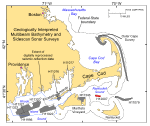 |
Figure 1. Index map of the coastal waters off southeastern New England showing location of the H12007 study area in central Nantucket Sound (red polygon) and the locations of earlier studies completed as part of this series (gray polygons). These earlier studies include (1) the Outer Cape survey (Poppe and others, 2006) and National Oceanic and Atmospheric Administration surveys H11076—Quicks Hole (Poppe and others, 2007a), H11079—Great Round Shoal Channel (Poppe and others, 2007b), H11077—Woods Hole (Poppe and others, 2008), and H11346—Edgartown (Poppe and others 2010) off Massachusetts; and (2) H11320 (McMullen and others, 2007), H11321 (McMullen and others, 2008), H11322 (McMullen and others, 2009a), H11922 (Poppe and others, 2011), H11996 (McMullen and others, 2011) and the extent of digitally reprocessed seismic-reflection data (McMullen and others, 2009b) (blue outline) off Rhode Island. |
 |
Figure 2. Map showing locations of end moraines (black polygons) in southern New England and on Long Island, New York. The Ronkonkoma-Nantucket moraine marks the southern extent of the Laurentide Ice Sheet at a glacial maximum about 20 to 24 ka and the Harbor Hill-Roanoke Point-Charlestown-Buzzards Bay moraine represents the ice-sheet position after a readvance about 18 ka (Uchupi and others, 1996). Underwater extensions of the moraines are shown as dashed lines. The study area is shown as a red polygon. (Modified from Stone and Borns, 1986; and Gustavson and Boothroyd, 1987.) |
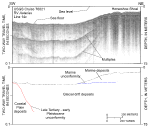 |
Figure 3. Segment of Uniboom seismic-reflection profile collected across the northwestern part of the study area (RV Asterias 76021, line 14c; O'Hara and Oldale, 1987). Profile reveals that (1) the stratigraphic section is composed of Coastal Plain, glacial drift, and marine deposits; (2) glacial drift is exposed in this part of the channel between Horseshoe and Cross Rip Shoals; and (3) Horseshoe Shoal is composed of Holocene marine deposits. Location of seismic profile is shown in figure 20. |
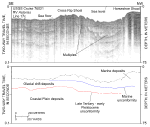 |
Figure 4. Segment of Uniboom seismic-reflection profile collected across the eastern extension of Cross Rip Shoal (RV Asterias 76021, line 17c; O'Hara and Oldale, 1987). Profile shows that (1) marine sediments thicken eastward on the floor of the channel between Horseshoe and Cross Rip Shoals, but are thin or absent south of Cross Rip Shoal; and (2) Cross Rip Shoal is composed of Holocene marine deposits. Location of seismic profile is shown in figure 20. |
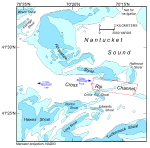 |
Figure 5. Map showing the major physiographic features in the vicinity of the study area (National Oceanic and Atmospheric Administration, 1996), the extent of the multibeam bathymetric dataset, and the maximum strengths and directions of the flood and ebb tidal flow in Cross Rip Channel (White and White, 2010), a section of the main channel that runs east-west through Nantucket Sound. |
 |
Figure 6. Port-side view of the National Oceanic and Atmospheric Administration Ship Thomas Jefferson at sea. Note that the 30-foot survey launch normally stowed on this side of the ship has been deployed. |
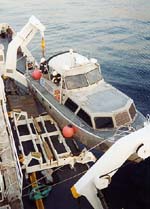 |
Figure 7. Launch 3102 being deployed from the National Oceanic and Atmospheric Administration Ship Thomas Jefferson. |
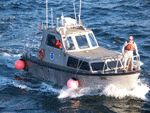 |
Figure 8. Starboard-side view of the National Oceanic and Atmospheric Administration launch 3102 at sea. |
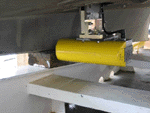 |
Figure 9. The RESON Seabat 8125 multibeam echosounder hull-mounted to the National Oceanic and Atmospheric Administration launch 3101. |
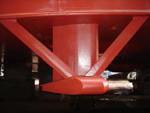 |
Figure 10. The RESON 7125 multibeam echosounder hull-mounted to the National Oceanographic and Atmospheric Administration Ship Thomas Jefferson. |
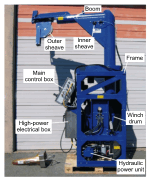 |
Figure 11. Brooke Ocean Technology Moving Vessel Profiler with a Sea-Bird Electronics, Inc., conductivity-temperature-depth (CTD) profiler used to correct sound velocities for the multibeam data collected aboard the National Oceanic and Atmospheric Administration Ship Thomas Jefferson. |
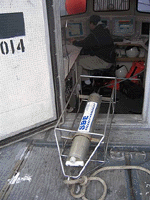 |
Figure 12. Sea-Bird Electronics, Inc., SEACAT conductivity-temperature-depth (CTD) profiler. Data derived from frequent deployments of this device were used to correct sound velocities for multibeam data collected aboard the launches. |
 |
Figure 13. Port-side view of the U.S. Geological Survey (USGS) RV Rafael, which was used to collect bottom photographs and sediment samples during USGS cruise 2011-006-FA. |
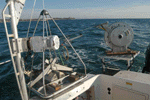 |
Figure 14. View of the small SEABOSS, a modified Van Veen grab sampler equipped with still and video photographic systems, mounted on the aft starboard side of the RV Rafael. Note the winch mounted on the davit (left) and the take-up reel for the video-signal and power cable (right). |
 |
Figure 15. Map showing the station locations used to verify the acoustic data with bottom sampling and photography during U.S. Geological Survey cruise 2011-006-FA. |
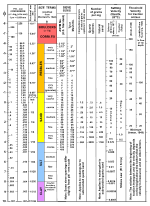 |
Figure 16. Correlation chart showing the relations among sediment phi size, diameter in millimeters, size classification (Wentworth, 1922), and American Society for Testing Materials (ASTM) and Tyler sieve sizes. Chart also shows the corresponding intermediate diameters, grains per milligram, settling velocities, and threshold velocities for traction. |
 |
Figure 17. Sediment classification scheme from Shepard (1954), as modified by Schlee (1973) and Poppe and others (2004). |
 |
Figure 18. Digital terrain model (DTM) of the sea floor produced from multibeam bathymetry collected during National Oceanic and Atmospheric Administration survey H12007 in central Nantucket Sound, offshore of southeastern Masscahusetts. Image is sun-illuminated from the north and vertically exaggerated (5x). "Warmer" colors indicate shallower areas; "cooler" colors indicate deeper areas. See explanation for depth ranges. |
 |
Figure 19. Locations of detailed planar views of the digital terrain model (yellow polygons), Uniboom seismic-reflection profiles (red lines) shown in figures 3 and 4, and bathymetric profiles of bedform morphology (blue lines) shown in figures 26, 27, and 29. |
 |
Figure 20. Detailed planar view of the bathymetric data collected during National Oceanic and Atmospheric Administration survey H12007 showing the sea floor along the axis of Cross Rip Channel. Note that asymmetrical scour around the shipwreck indicates net eastward transport and that the sea floor is dominated by megaripples and small patches of gravel pavement. Location of view is shown in figure 19. |
 |
Figure 21. Detailed planar view of the bathymetric data collected during National Oceanic and Atmospheric Administration survey H12007 showing boulders on the sea floor along within Cross Rip Channel. Note that scour is present around the boulder to the west and that the sea floor is dominated by relatively flat patches of gravel pavement. Location of view is shown in figure 19. |
 |
Figure 22. Interpretation of the bathymetric data collected during National Oceanic and Atmospheric Administration survey H12007 as verified by sampling and bottom photography during U.S. Geological Survey cruise 2011-006-FA. Interpretation shows the distributions of sand waves and megaripples, shell beds, and shipwrecks. |
 |
Figure 23. Detailed planar view of the bathymetric data collected during National Oceanic and Atmospheric Administration survey H12007 showing the southern flank of Horseshoe Shoal and the location of station CR13. Note that megaripples are common on the westward-facing stoss slopes of the sand waves; both transverse and barchanoid sand-wave morphologies are present; and the seabed just east of the shipwreck is relatively smooth, indicating scour. Location of view is shown in figure 19. |
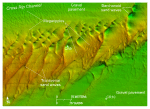 |
Figure 24. Detailed planar view of the bathymetric data collected during National Oceanic and Atmospheric Administration survey H12007 extending across the eastern part of Cross Rip Shoal and the locations of stations CR9 and CR10. Note that megaripples are common on the floor of Cross Rip Channel and on the stoss slopes of the sand waves; the symmetry of the sand waves is different on the northern flank, crest, and southern flank of the shoal; and scour has produced deep troughs in the lee of the barchanoid sand waves. Location of view is shown in figure 19. |
 |
Figure 25. Detailed planar view of the bathymetric data collected during National Oceanic and Atmospheric Administration survey H12007 showing the southwestern part of Halfmoon Shoal and the location of station CR16. Note that transverse morphologies dominate the sand waves and that megaripples cover the sea floor surrounding the shoal. Location of view is shown in figure 19. |
 |
Figure 26. Cross sectional views of sand waves produced from the bathymetric data collected during National Oceanic and Atmospheric Administration survey H12007 showing bedform asymmetry along the flanks of Horseshoe Shoal (profile A) and Cross Rip Shoal (profile B). Slip-face orientation indicates net eastward sediment transport in both profiles (Reineck and Singh, 1980). Locations of profiles are shown in figure 19. |
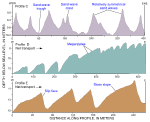 |
Figure 27. Cross-sectional views of sand waves produced from the bathymetric data collected during National Oceanic and Atmospheric Administration survey H12007 from the crest (profile C) and across the western flanks of the extension of Cross Rip Shoal (profile D) and Halfmoon Shoal (profile E). The megaripples in profile C are predominantly symmetrical, but bedform asymmetry and slip-face orientation (Reineck and Singh, 1980) in profiles D and E indicate net eastward sediment transport. Locations of profiles are shown in figure 19. |
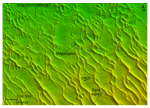 |
Figure 28. Detailed planar view of the bathymetric data collected during National Oceanic and Atmospheric Administration survey H12007 showing the southeastern part of the study area and the location of station CR20. Note that megaripples dominate the sea floor in this area, but that they built to sand waves in the southeastern corner of the study area. Location of view is shown in figure 19. |
 |
Figure 29. Cross-sectional views of megaripples produced from the digital terrain model of bathymetric data collected during National Oceanic and Atmospheric Administration survey H12007 in the southeastern part of the study area. The megaripples are predominantly symmetrical, indicating little or no net transport. Locations of profiles are shown in figure 19. |
 |
Figure 30. Map showing the station locations from U.S. Geological Survey cruise 2011-006-FA that were used to verify the acoustic data. Color of station symbol indicates sediment texture. "Warmer" colors indicate coarser sediments; "cooler" colors indicate finer sediments. |
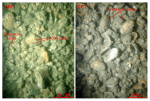 |
Figure 31. Bottom photographs from stations CR2 and CR7 showing the shell beds that cover the sea floor along the axis of Cross Rip Channel. Note that Crepidula and surf clam valves make up the majority of the shells, the shells are commonly encrusted with barnacles, and some of the surf clams are alive. Station locations are shown in figures 15 and 30. |
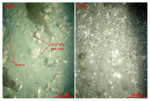 |
Figure 32. Bottom photographs from stations CR1 and CR6 showing the gravelly sediment that covers the sea floor along the sides of Cross Rip Channel. Note the patchy distribution of the gravel, slight scour depressions adjacent to the larger obstructions, and the ubiquitous presence of shell debris. Station locations are shown in figures 15 and 30. |
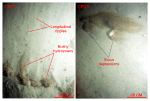 |
Figure 33. Bottom photographs from stations CR21 and CR23 showing the flat, current-swept appearance of the sea floor in some areas southeast of Cross Rip Shoal. Note the presence of faint longitudinal ripples, scour features, and bushy hydrozoans. Station locations are shown in figures 15 and 30. |
 |
Figure 34. Distribution of sedimentary environments based on the digital terrain model produced from National Oceanic and Atmospheric Administration survey H12007 and the sampling and photography data from USGS cruise 2011-006-FA that were used to verify the acoustic data. Areas characterized by processes associated with erosion or nondeposition and coarse bedload transport are shown. |
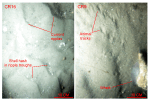 |
Figure 35. Bottom photographs from stations CR9 and CR16 showing the rippled sea floor that covers areas characterized by processes associated with coarse bedload transport. Note that shell debris collects in ripple troughs. Station locations are shown in figures 15 and 30. |